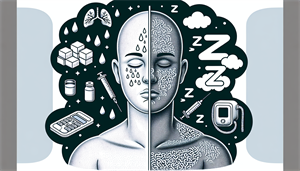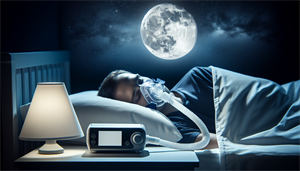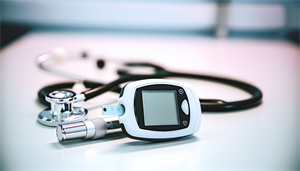How exactly do diabetes and sleep apnea affect each other, and what does this mean for individuals facing these diagnoses?
It’s essential to uncover how these conditions can escalate in tandem, complicating treatment and management. In the following sections, we’ll dissect the relationship between diabetes and sleep apnea, shed light on their combined prevalence, and provide a guide to recognizing symptoms, navigating treatments, and implementing monitoring practices to keep them both in check.
Key Takeaways
-
There is a bidirectional relationship between diabetes and obstructive sleep apnea (OSA), with each condition potentially worsening the other. Shared risk factors include obesity and insulin resistance, with OSA contributing to impaired glucose metabolism and diabetes potentially exacerbating OSA.
-
Diabetic patients have a higher prevalence of sleep apnea than the general population, with rates varying significantly, particularly in obese diabetic patients. These findings support the need for regular screening for sleep apnea in diabetic individuals.
-
Effective management of sleep apnea in diabetic patients involves CPAP therapy, weight management, and lifestyle changes such as diet and exercise. These interventions can improve both sleep quality and blood sugar control, thereby addressing both conditions simultaneously.
The Bidirectional Relationship Between Diabetes and Sleep Apnea

A bidirectional link exists between diabetes and obstructive sleep apnea (OSA), with each condition potentially exacerbating the other. Obesity and insulin resistance are shared risk factors of note. People with OSA often experience an increase in blood sugar levels impacting insulin release and thus affecting glucose levels throughout the day.
Sleep apnea disrupts glucose metabolism in individuals with type 2 diabetes, which can contribute to glucose intolerance. This impaired glucose metabolism occurs through sympathetic activation, oxidative stress, inflammation, and neuroendocrine dysregulation. The disruption is further aggravated by intermittent hypoxia, a consequence of sleep apnea, which directly affects hepatocytes leading to elevated cellular glycogen content and increased gluconeogenic enzymatic activity.
How Sleep Apnea Contributes to Insulin Resistance
Two key mechanisms - intermittent hypoxemia and sleep fragmentation - can cause sleep apnea to lead to insulin resistance, a precursor to diabetes. These disruptions to normal sleep patterns interfere with glucose metabolism, raising the chances of developing type 2 diabetes, especially in untreated obstructive sleep apnea cases.
Hypoxemia, a condition marked by low levels of oxygen in the blood, affects insulin effectiveness by impeding the distribution of insulin to cells, reducing cell responsiveness to insulin, and causing elevated blood glucose levels, leading to impaired glucose tolerance. Intermittent hypoxemia, in particular, alters glucose metabolism by reducing glucose-induced insulin secretion and inducing a metabolic shift from aerobic to anaerobic processes.
On the other hand, sleep fragmentation, particularly in instances of obstructive sleep apnea, leads to deteriorated glucose tolerance and decreased insulin sensitivity, thereby contributing to insulin resistance. Continuous positive airway pressure (CPAP) therapy, a common treatment option for sleep apnea, can effectively mitigate these issues.
How Diabetes Can Lead to Sleep Apnea
Despite the complex and not fully understood relationship between diabetes and sleep apnea, there is evidence to suggest that diabetes may impact central respiratory control and potentially contribute to obstructive sleep apnea. This is due to:
-
The influence of diabetic neuropathy on central regulation of respiration
-
The influence of diabetic neuropathy on upper airway neural reflexes
-
Sleep-disordered breathing
-
Potentially contributing to central sleep apnea.
Diabetes can further contribute to obstructive sleep apnea by promoting obstructive sleep, leading to a higher prevalence of sleep apnea among patients with obstructive sleep. This highlights the importance of treating sleep apnea in diabetic patients to prevent further complications.
The Prevalence of Sleep Apnea Among Diabetic Patients

Compared to the general population, diabetic patients have a notably higher prevalence of sleep apnea. While about 26% of adults between the ages of 30 and 70 years in the general population have sleep apnea, rates among diabetic patients range from 15.2% to 90.3%. This prevalence is even higher in cases of moderate to severe sleep apnea. This divergence points to the importance of understanding the presence of sleep apnea in diabetic patients and the need for regular screening.
The influence of obesity on the prevalence of sleep apnea in diabetic patients is significant. Research indicates that obstructive sleep apnea (OSA) prevalence increases from 7.3% in diabetic individuals with a BMI less than 25 kg/m2 to a concerning 62.2% in obese patients with a BMI exceeding 30 kg/m2. In fact, there is a notable presence of undiagnosed OSA in patients with type 2 diabetes, with rates ranging from 24% to 86%.
The frequency of sleep apnea among obese diabetic patients is remarkably high, with estimates varying from 18% to 86%. This broad range emphasizes the significance of heightened awareness and methodical screening within this demographic, as well as the importance of effective sleep apnea treatment.
Even in the absence of obesity, sleep apnea impacts a considerable proportion of diabetic patients, with a prevalence of around 40%. This indicates a strong connection between the condition and diabetes beyond its association with obesity. Sleep apnea is also a risk factor for cardiovascular disease, which is another reason to address it in diabetic patients.
Identifying Sleep Apnea Symptoms in Diabetic Patients

Effectively managing sleep apnea begins with recognizing its symptoms. Diabetic patients should be aware of common symptoms such as snoring, daytime sleepiness, and frequent nighttime awakenings as these indicators can aid in the early identification and management of the condition.
Screening for sleep apnea risk involves asking about the following symptoms:
-
Regular snoring
-
Waking up gasping or choking
-
Excessive daytime sleepiness
-
Morning headaches
-
Difficulties with memory or concentration
Early diagnosis and initiation of sleep apnea treatment can significantly improve the patient’s quality of life and help manage diabetes more effectively.
It’s noteworthy that individuals with type 1 diabetes exhibit a higher susceptibility to obstructive sleep apnea, whereas there is a significant interdependent association between sleep apnea and type 2 diabetes. This underscores the importance of monitoring symptoms in both types of diabetes.
Treatment Options for Managing Sleep Apnea in Diabetics

A multipronged approach is required to manage sleep apnea in diabetics. The primary treatment option is CPAP therapy, a form of continuous positive airway pressure treatment that uses a mask connected to a machine to deliver pressurized air, thus ensuring the maintenance of open airways during sleep. This therapy plays a role in diabetes management by facilitating restful sleep, a crucial factor in maintaining healthy diabetes management and enabling improved blood sugar control.
In addition to CPAP therapy, alternative treatment options to treat sleep apnea include weight loss and lifestyle changes such as proper diet and exercise. These interventions can contribute to the improvement of sleep quality and blood sugar control, effectively addressing both sleep apnea and diabetes.
Oral appliances are another viable treatment option for sleep apnea, especially for individuals who are unable to tolerate continuous positive airway pressure (CPAP) therapy. Their mode of action involves preventing the obstruction of the airway during sleep by the tongue and tissues in the back of the throat.
CPAP Therapy and Its Impact on Glucose Control
By ensuring open airways during sleep, CPAP therapy could potentially enhance glucose control in diabetic patients. Research indicates that as many as 59% of patients experience improved glycemic control as a result of positive airway pressure treatment. CPAP treatment demonstrated a significant improvement in insulin sensitivity as assessed by oral glucose tolerance test (GTT) and also showed potential for reducing 24-hour blood pressure.
The mechanism by which CPAP therapy contributes to the maintenance of open airways during sleep is by delivering mild air pressure to keep the airways open. This is essential in preventing sleep apnea disruptions that can have an impact on glucose metabolism.
Diabetic patients may observe an enhancement in glucose control after one week of optimal CPAP use or following nightly 8-hour CPAP treatment over a span of 2 weeks. This highlights the importance of sleep apnea treatment in managing diabetes.
Lifestyle Changes for Better Sleep and Blood Sugar Management
Besides CPAP therapy, weight loss and lifestyle changes such as a proper diet and exercise are alternative treatment options for managing sleep apnea in diabetics. Weight management is crucial for addressing sleep apnea and diabetes as obesity is a prevalent risk factor for both conditions. Shedding excess weight can enhance symptoms of sleep apnea and aid in the regulation of blood sugar levels in diabetes, especially in obese patients.
Regular exercise has been associated with the following benefits:
-
Enhancements in cardiorespiratory fitness
-
Reduction of daytime drowsiness
-
Significant health advantages for individuals with type 2 diabetes
-
Enhanced muscle insulin sensitivity in those with prediabetes and type 2 diabetes, contributing to improved management of these conditions, even in cases of moderate to severe sleep apnea.
Diet significantly affects blood sugar control for individuals with diabetes, as it is linked to the risk of insulin resistance and suboptimal glycemic control. A diabetes diet entails:
-
Consuming nutritious foods in moderate quantities
-
Adhering to consistent meal schedules
-
Including nutrient-rich foods such as vegetables, fruits, and whole grains, which offer high nutritional value per calorie and are abundant in fiber
These dietary practices are particularly beneficial for individuals with diabetes.
In order to enhance the quality of sleep, one can consider engaging in the following activities:
-
Meditation
-
Deep breathing
-
Writing, expressing gratitude
-
Investing in a comfortable mattress and bedding
-
Minimizing light exposure
-
Reducing noise
-
Maintaining a temperature range of 65 to 68 degrees Fahrenheit
-
Limiting caffeine consumption
-
Avoiding nicotine
-
Reducing intake of spicy, acidic, and fatty foods
These activities can help improve your sleep and ensure a restful night.
Furthermore, it is advisable to refrain from eating late at night and to engage in physical exercise earlier in the day.
Monitoring Sleep Quality and Glucose Levels

For diabetic patients with sleep apnea, monitoring sleep quality and glucose levels is vital. This allows for improved management of both conditions and helps minimize health complications. Continuous Glucose Monitoring (CGM) devices, such as the FreeStyle Libre, are widely regarded as the most effective for monitoring glucose levels in diabetic patients.
A fasting blood sugar level can be categorized as follows:
-
Below 100 mg/dL (5.6 mmol/L): normal range for individuals with diabetes
-
100 to 125 mg/dL (5.6 to 6.9 mmol/L): prediabetes
-
126 mg/dL (7.0 mmol/L) or higher: indicative of diabetes.
In diabetic patients, inadequate sleep quality has been linked to elevated blood glucose levels. Therefore, it is crucial for diabetic individuals to emphasize the development of good sleep habits in order to manage their blood sugar levels effectively.
Inadequate sleep quality in individuals with obstructive sleep apnea syndrome, also known as obstructive sleep apnoea, may manifest through various clinical symptoms and diminished overall sleep duration.
Preventative Measures for Reducing the Risk of Sleep Apnea and Diabetes
The risk of developing sleep apnea and diabetes can be reduced through preventative measures such as weight loss, regular exercise, and maintaining a healthy diet. These measures can also improve the management of existing conditions. Weight loss has the potential to enhance glycemic control, alleviate the severity of sleep apnea, and decrease the risk of complications linked to diabetes.
Regular exercise contributes to the prevention of these conditions by:
-
Enhancing insulin sensitivity
-
Decreasing blood pressure
-
Mitigating the severity of sleep apnea
-
Improving cognitive function
-
Enhancing blood glucose regulation
-
Lowering cardiovascular risk factors
-
Promoting overall well-being and sleep quality.
Consuming a diet that is abundant in antioxidants may improve the quality of sleep and decrease inflammation. To prevent diabetes, it is advised to restrict the intake of butter and trans fats, refrain from consuming sugary drinks, and moderate the consumption of milk/dairy to 1-2 servings per day.
The use of tobacco and alcohol can heighten the likelihood of developing sleep apnea, consequently increasing the susceptibility to insulin resistance and type 2 diabetes. Furthermore, tobacco usage is a recognized factor in the development of type 2 diabetes.
In addition to weight management and diet, other lifestyle modifications that can decrease the risk of sleep apnea include:
-
increasing physical activity
-
cessation of drinking and smoking
-
avoiding certain medications
-
adjusting sleep behavior.
Summary
In conclusion, it is evident that diabetes and sleep apnea share a complex, bidirectional relationship, with each condition exacerbating the other. The increased prevalence of sleep apnea among diabetic patients underscores the need for increased awareness, rigorous screening, and effective management strategies. Recognizing the symptoms of sleep apnea can facilitate early diagnosis and treatment, which can significantly improve the patient’s quality of life and diabetes management. Treatment options such as CPAP therapy and lifestyle modifications, coupled with continual monitoring of sleep quality and glucose levels, can aid in effectively managing both conditions. Preventative measures such as weight loss, regular exercise, and a healthy diet can reduce the risk of developing these conditions.
Frequently Asked Questions
Is sleep apnea associated with diabetes?
Yes, studies have shown that obstructive sleep apnea (OSA) is 71% more prevalent in patients with Type 2 diabetes, likely due to the common factor of obesity. It's important for diabetic patients to also consider the impact of sleep quality on their condition.
Does a CPAP machine help with diabetes?
Yes, using a CPAP machine can help improve blood glucose levels and reduce fluctuations for patients with diabetes, as shown in clinical studies and research.
What is the average age of death for sleep apnea patients?
The average age of death for sleep apnea patients is 66.8 years, with a range of 42 to 86 years. The mortality rate increases with the severity of OSA.
How long will it take to reverse damage from sleep apnea?
Treating sleep apnea with CPAP for just 12 months can almost entirely reverse damage done to white matter, improving sleep and reducing cognitive issues.
Symptoms of sleep apnea?
Some symptoms of sleep apnea include: [insert symptoms here]. It's important to consult a healthcare professional if you experience these symptoms.


